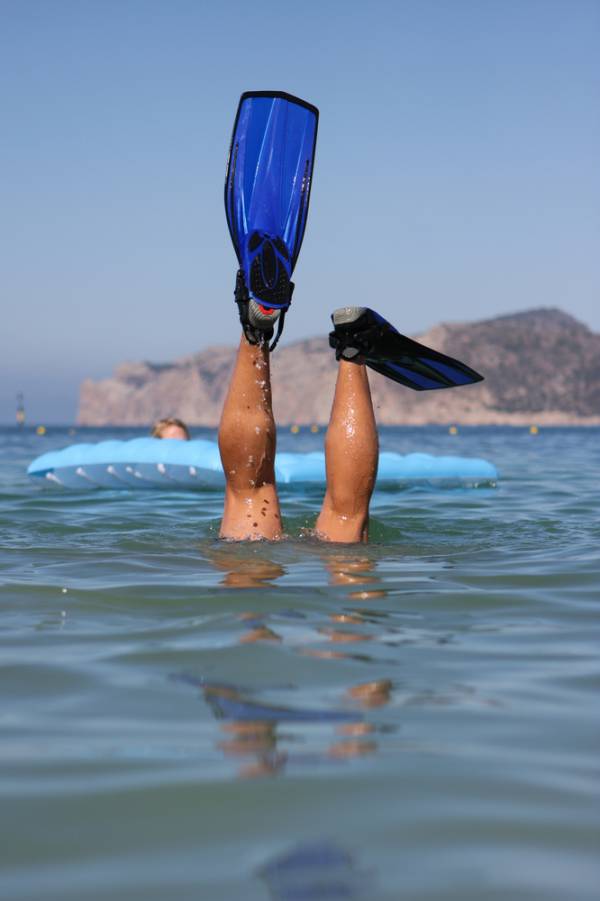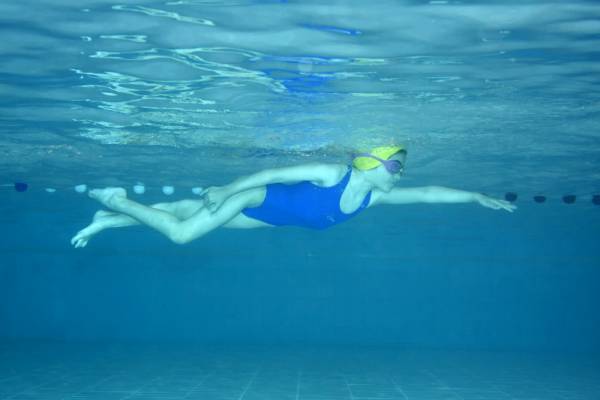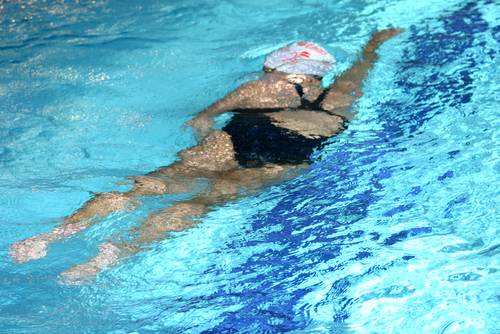If you read the title of the article and you identified with it, I regret to inform you that you are absolutely wrong. You often hear triathletes or even open water swimmers state they don’t need to kick on the swim, that it is all upper body and no focus should be put on lower body work. I even had a swimmer request I don’t give out kick sets because it is useless for him to work his legs. Absurd! Your legs are right there behind you when you swim, perhaps you won’t get much propulsion from them when you swim, but it is crucial to learn to kick smart if you are going to be efficient in your swims.
You might ask, “So if I am not going to get any propulsion from my kick, why is it so important that I work it?” Simple – making the kick more effective will decrease the effort required to swim by reducing drag in the water.
Previously we covered the importance of head and hip positions to make you a faster and more efficient swimmer. If those skills are not yet mastered, you may want to brush up on them before attempting to fix your kick.
There are four key factors that will contribute to an efficient kick:
- The kick should be low drag.
- The timing of the kick should drive rotation.
- The kick should be low effort.
- More importantly, the kick should come from the hip.
One of the key skills for great kicking is ankle flexibility. While most swimmers have great ankle and foot flexibility, I often find the average recreational swimmer or triathlete does not. Each of these flexibilities provides important features to the efficient kick.
Foot Flexibility
 The key here is to differentiate between plantar flexion and dorsiflexion. An effective kick will feature great plantar flexion, when you point your toes in your kick. This presents a much lower profile to the water, while dorsiflexion (flexing yours toes back toward your shin) will not only kick water in the wrong direction creating negative propulsion, it will create extra drag from the exposed foot.
The key here is to differentiate between plantar flexion and dorsiflexion. An effective kick will feature great plantar flexion, when you point your toes in your kick. This presents a much lower profile to the water, while dorsiflexion (flexing yours toes back toward your shin) will not only kick water in the wrong direction creating negative propulsion, it will create extra drag from the exposed foot.
Ankle Flexibility
Ankle flexibility goes hand in hand with foot flexibility. Great ankle flexibility usually leads to good plantar flexion. Thus, your toe pointing will be limited to how flexible your ankles are. As a swimmer I am able to flex my foot beyond straight, providing me great foot amplitude (my foot turns into a “fin”). However this hyper-flexibility presents issues when it comes to my running. So word of caution here, while you want to increase your ankle flexibility in order to give you the best kick you can possibly achieve, you will want to be conscious that if you intend to run or cycle you may not want overly flexible ankles.
A good way to practice ankle flexibility is the use of fins for kicking. I would recommend shorter blade fins (FINIS makes three great versions of these). If your ankle flexibility is poor the longer the blade of the fin the more likely you will develop cramping of your calf muscles. It is tempting to constantly use fins because it makes you faster. Don’t fall into the temptation of using fins as a crutch; try to approach them as an instrument of training and use them only for that purpose.
Kicking From the Hip
 One of the major issues I find with swimmers, and definitely triathletes, is the inability to kick from the hip. This usually looks like the swimmer is trying to pedal a bicycle under the water with their legs, and happens because the athlete bends their knees too much while kicking. You don’t have to be a swimmer to realize this kicking technique causes a lot of drag and will without a doubt lead to sinking of the legs (even if your head and hips were in the right position to begin with).
One of the major issues I find with swimmers, and definitely triathletes, is the inability to kick from the hip. This usually looks like the swimmer is trying to pedal a bicycle under the water with their legs, and happens because the athlete bends their knees too much while kicking. You don’t have to be a swimmer to realize this kicking technique causes a lot of drag and will without a doubt lead to sinking of the legs (even if your head and hips were in the right position to begin with).
This is particularly common among triathletes who, through cycling and running, develop power from the knee. So we reteach them to kick from the hip. Kicking from the hip presents a relatively straight leg, with a slight bend of the knee on the down stroke. Imagine it more as keeping the knee/leg relaxed as opposed to kicking with a tense leg, which is the first mistake swimmers make when asked to kick with a straight leg. The power of the kick will then be transferred from the knee to the hip, preventing sinking of the knee and thigh and thus reducing drag from the exposed thigh.
Timing of the Kick
The most widely used kicking strategies are the 2-beat and the 6-beat kick. This means that the swimmer uses 2 or 6 kicks per stroke cycle (in freestyle a stroke cycle is described as 2 strokes, one per arm). The 6-beat kick is the most common and widely employed by most swimmers. It is also referred as the flutter kick and usually more propulsion is generated from this kick, however it is also more energy consuming and therefore potentially more useful to swim shorter distances. This makes it by no means exclusively useful in sprinting. The flutter intensity can be controlled to make it also effective for distance races, although it will require careful training and planning as to not over-kick.
 The 2-beat kick is especially suited for long swims and triathlons. It uses 2 kicks per stroke cycle, it is slow and economical. However, it requires skill to master. Don’t feel pressured to use a 2-beat kick. It may not be the most effective for everyone. Try it, train it, but if it doesn’t feel natural, revert to what does, making sure the kick is coming from the hip with pointed toes.
The 2-beat kick is especially suited for long swims and triathlons. It uses 2 kicks per stroke cycle, it is slow and economical. However, it requires skill to master. Don’t feel pressured to use a 2-beat kick. It may not be the most effective for everyone. Try it, train it, but if it doesn’t feel natural, revert to what does, making sure the kick is coming from the hip with pointed toes.
Ultimately my message to those who state “I’m a triathlete, I don’t need to kick” is, do you want legs that are dead behind you and dragging along while your upper body plows through the water? Or would you like legs that kick, and although not significantly adding to your swimming speed ensure that your body stays in the right position significantly decreasing the drag and therefore the amount of energy your upper body needs to make you move in the water?
Photos courtesy of Shutterstock.






